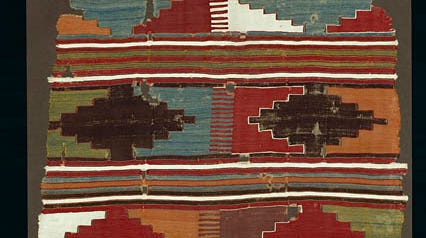The Art of the Anatolian Kilim: Highlights from the McCoy Jones Collection
Aug 17, 2011
Kilim, 18th–19th century,
Turkey, Anatolia. Wool; slit tapestry weave, 132 x 71 in.
(335.3 x 180.3 cm).
The Caroline and H. McCoy Jones Collection, Gift of Caroline McCoy-Jones, 2000.202.6
A world-class collection of Anatolian kilims gifted to the Fine Arts Museums of San Francisco by Caroline McCoy-Jones from 1988–89 is showcased in a choice exhibition of two dozen of the finest examples. Presented in the textile arts gallery at the de Young September 10, 2011 through July 29, 2012, the pre-19th-century Anatolian flat-woven kilims on view include a variety of design types, regional styles, as well as superb examples of artistic and visual prowess. The kilims in the Fine Arts Museums of San Francisco’s permanent collection are considered the most important group of Anatolian kilims outside Turkey.
Major patrons to the Fine Arts Museums Textile Arts Department, Caroline and H. McCoy Jones have generously donated more than 800 textile works to the museum. The importance of these collectors is paramount in the textile arts community and The Art of the Anatolian Kilim is a celebration of their gift. Curator Jill D’Alessandro explains, “The first presentation of works from this collection in 1990 signified a breakthrough in the appreciation of this weaving tradition. Not only was it the first time a Western museum had mounted a major exhibition dedicated to Anatolian kilims, but it was also the first time that kilims of this age, rarity and fragility were seen by the public; subsequently, the Anatolian kilim entered into the pantheon of the textile arts. With more than 20 years passing since this important collection made its public debut, many visitors, scholars and textile enthusiasts will be able to enjoy and study them for the first time.”
Kilims
This selection of dynamic weavings were produced between the 15th and 19th centuries by seminomadic and village women of Anatolia, the land east of the Aegean often called Asia Minor by ancient geographers that constitutes much of present-day Turkey. Woven in the slit-tapestry technique, primarily from the wools of sheep, goats or camels, these works obtained their rich, earthy hues from natural dyes derived from locally harvested sources (with the exception of indigo, which is imported). The kilims are characterized by bold abstract designs that have been translated as symbolic renderings of architectural, human, animal and floral motifs, some of which trace back to Neolithic times.
Kilims were not only created for personal use but also serve as an expression of group identity, a representation of wealth and a source of currency. Over the centuries and up to modern times, both technique and design have been passed down from generation to generation of Anatolian women. Traditionally, they were used as floor and table coverings, room dividers, door flaps, prayer rugs and burial cloths. Many were given to local mosques to be used as floor coverings—layered one on top of another, they lent warmth and comfort. The kilim was also an important part of a bride’s dowry.
D’Alessandro explains, “These surviving examples, in their fragmented states, show the passage of time. Although structural disintegration has interrupted the design field on some of these pieces, their colors remain deeply saturated and their patterns simple and powerful.”
The term kilim is not a technical term in that it defines a particular woven structure. It appears to have originated in the Near East as a general designation for flat-weaves—textiles without pile. In the past decade the term kilims has been used almost exclusively to denote textiles in slit-tapestry weave.
Related Programs
Thursday, September 1 \ 1 pm
de Young \ Koret Auditorium
Curator Lecture: Anatolian Archetypes: The McCoy Jones Kilim Collection, Jill D’Alessandro, Curator of Costume and Textile Arts, FAMSF
Free and open to the public.
Saturday, October 15 \ 10 am
de Young \ Koret Auditorium
Textile Arts Council Lecture: Discontinuous Wefts: The Brilliance and Beauty of Anatolian Kilims, Cathryn Cootner, Textile Curator Emeritus, FAMSF
Free and open to the public.
Exhibition Organization
The Art of Anatolian Weaving: Highlights from the McCoy Jones Kilim Collection is organized by FAMSF and celebrates gifts from Caroline and H. McCoy Jones. Major Sponsors are Francesca Passalacqua and D. E. Hardy, and the Turkish Cultural Foundation—Natural Dye Research and Development Laboratory. Lead Sponsors are S. Peter Poullada and Nancy Sheppard, the San Francisco Bay Area Rug Society and George Hecksher. Sponsors are Bruce P. and Olive W. Baganz, the Board of the Textile Arts Council, Dr. Donald Breyer, Mary F. Connors, Levon Der Bedrossian, Thomas Murray Asiatica–Ethnographica, and Yvette Rogers. Support for the exhibition is also provided by the H. McCoy Jones Trust.
Textile Arts Collection
The Fine Arts Museums’ textiles collection boasts more than 12,000 textiles and costumes from around the world. It is one of the largest and most comprehensive collections of its type in the United States. It comprises costume and costume accessories, loom-woven textiles, non-woven fabrics such as bark cloth, felt and knitting, and objects whose primary decoration is produced through techniques such as beading and embroidery. With holdings that span two and a half millennia and represent cultures from 125 countries, the textile arts collection enables the museums to draw connections across cultures and enrich its other collections.
